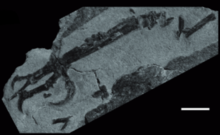太陽神鳥屬
太陽神鳥屬(學名:Intiornis,意思是「因蒂鳥」(因蒂為印加神話中的太陽神),種名Intiornis inexpectatus的意思是「意想不到的太陽鳥」[1]),中文更常見的名稱為太陽鳥[註 1]。這是一種已滅絕的鳥龍鳥科的反鳥類,在白堊紀晚期(坎帕期)存在於現在的阿根廷西北部。[2]
| 意外太陽神鳥 化石時期:坎帕期
~ | |
|---|---|

| |
| 太陽神鳥的正模部分後肢 | |
| 科學分類 | |
| 界: | 動物界 Animalia |
| 門: | 脊索動物門 Chordata |
| 綱: | 蜥形綱 Sauropsida |
| 總目: | 恐龍總目 Dinosauria |
| 目: | 蜥臀目 Saurischia |
| 亞目: | 獸腳亞目 Theropoda |
| 演化支: | 鳥翼類 Avialae |
| 演化支: | †反鳥亞綱 Enantiornithes |
| 科: | †鳥龍鳥科 Avisauridae |
| 屬: | †太陽神鳥屬 Intiornis Novas et al. 2010 |
| 種: | †意外太陽神鳥 I. inexpectatus
|
| 二名法 | |
| †Intiornis inexpectatus Novas et al. 2010
| |
描述
編輯該屬可以從在上白堊紀的拉斯庫爾蒂恩布雷斯組(Las Curtiembres Formation)中發現的部分後肢得知。太陽神鳥肢體上的三個主要腳趾長度幾乎相同。[1]
該物種於2010年由費爾南多·諾瓦斯、費德里科·阿格諾林和阿古斯丁·斯堪費拉命名,模式種為意外太陽神鳥(Intiornis inexpectatus)。太陽神鳥體長約15厘米,[1]大小如麻雀,是南美洲已知最小的反鳥類。它的近親是來自阿根廷西北部萊喬組(Lecho Formation,馬斯特里赫特期)的姐妹鳥龍鳥。[2]
系統發生學
編輯下面的分支圖來自Wang et al., 2022:[3]
| 反鳥類 Enantiornithes |
| |||||||||||||||||||||||||||||||||||||||||||||||||||||||||||||||||||||||||||||||||||||||||||||||||||||||||||||||||||||||||||||||||||||||||||||||||||||||||||||||||||||||||||||||||||||||||||||||||||||||||||||||||||||||||||||||||||||||||||||||||||||||||||||||
| l |
字母鍵:
b = 波羅赤鳥屬 Boluochia
c = 華夏鳥屬 Cathayornis
e = 反凰鳥屬 Enantiophoenix
f = 侯氏鳥屬 Houornis
h = 長翼鳥屬 Longipteryx
i = 副渤海鳥屬 Parabohaiornis
j = 翼鳥屬 Pterygornis
l = 烏如那鳥屬 Vorona
m = 原家窪鳥屬 Yuanjiawaornis
n = 雲加鳥屬 Yungavolucris
古生物學
編輯等長的長腳趾和彎曲的大爪表明棲息的適應性。[1]
註釋
編輯參考資料
編輯- ^ 1.0 1.1 1.2 1.3 Matthew P. Martyniuk. A Field Guide to Mesozoic Birds and Other Winged Dinosaurs. Pan Aves. 2012: 142 [29 August 2022]. ISBN 9780988596504. (原始內容存檔於2023-06-10).
- ^ 2.0 2.1 Fernando Emilio Novas; Federico Lisandro Agnolín; Carlos Agustín Scanferla. New enantiornithine bird (Aves, Ornithothoraces) from the Late Cretaceous of NW Argentina. Comptes Rendus Palevol. 2010, 9 (8): 499–503. doi:10.1016/j.crpv.2010.09.005.
- ^ Wang, Xuri; Cau, Andrea; Luo, Xiaoling; Kundrát, Martin; Wu, Wensheng; Ju, Shubin; Guo, Zhen; Liu, Yichuan; Ji, Qiang. A new bohaiornithid-like bird from the Lower Cretaceous of China fills a gap in enantiornithine disparity. Journal of Paleontology. 2022-02-11, 96 (4): 961–976. ISSN 0022-3360. S2CID 247432530. doi:10.1017/jpa.2022.12 (英語).